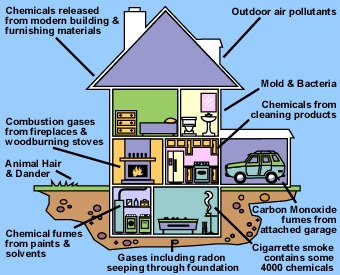Indoor Air Quality
For over 50 years, California residents have been fighting to improve the quality of the air they breathe outdoors. Their efforts have been well rewarded: levels of outdoor air pollutants have fallen dramatically. More recently the air quality battle has shifted indoors.
The air inside of homes and buildings is often more polluted than outdoor air with levels of certain chemicals being many times higher than they are outside. There's little doubt, inhaling these pollutants isn't good for your health and, in some cases, it’s outright dangerous.
Environmental Tobacco Smoke
Environmental tobacco smoke, or "second-hand smoke", is a mixture of hundreds of chemicals generated from the burning of tobacco products, such as cigarettes and cigars. Many of these chemicals are known to be toxic, and dozens of them have been identified as carcinogens (capable to causing cancer).
In indoor areas where people are smoking, the chemical contaminants in environmental tobacco smoke can build-up in the air, impacting the health of smokers and non-smokers alike. Every year, exposure to environmental smoke is estimated to cause 3,000 deaths from lung cancer and 50,000 deaths from heart disease in individuals who do not smoke. Children are particularly vulnerable to the effects of secondhand smoke. It not only contributes to a variety of respiratory illnesses, including pneumonia and asthma, it also increases the likelihood of Sudden Infant Death Syndrome, ear infections, and developmental delays.
Combustion Pollutants
Combustion pollutants are gases and particles produced when fuels like gas, oil, kerosene, wood, or coal are incompletely burned. Common indoor sources of combustion pollutants include woodstoves, fireplaces, stoves, furnaces, and water heaters.
The major pollutants released are carbon monoxide, nitrogen dioxide, and particles. By interfering with the delivery of oxygen throughout the body, carbon monoxide can cause a wide range of symptoms ranging from headaches, dizziness, and fatigue to nausea and disorientation. Individuals with heart or lung problems are particularly sensitive to the effects of carbon monoxide; in people with chronic heart disease, for example, carbon monoxide triggers episodes of chest pain.
Nitrogen dioxide causes eye, nose and throat irritation. It can also irritate the lining of the lung causing shortness of breath and, at high concentration or with prolonged exposure, increase the risk of respiratory infections. Children and individuals with respiratory diseases are at greatest risk from exposure.
Formaldehyde
Formaldehyde is a colorless, strong-smelling gas that is widely used to manufacture building materials like particleboard, fiberboard, and plywood. Products made with formaldehyde emit—or “off-gas”—small amounts of the gas, and low levels of formaldehyde can typically be detected in indoor air. Emissions are generally highest when the products are new and gradually decrease as they age.
Burning materials such as wood, kerosene, and natural gas also produces small amounts of formaldehyde and can contribute to indoor formaldehyde levels.
Health effects of formaldehyde depend on the level of exposure and can include burning and watery eyes; nose and throat irritation; coughing and difficulty breathing; or severe allergic reactions. In addition, formaldehyde has been shown to cause cancer in animals used for scientific research. Scientists are continuing to study long-term health effects in humans.
Lead
Lead presents a problem in many indoor environments. Old lead-based paint is the most significant source of indoor lead exposure. (Although the use of lead in house paint was banned in 1978, many older homes and buildings still have lead based-paint on their walls.) Lead dust forms when painted surfaces—like windows and window frames or doors and door frames—bump or rub together. Very high levels of dust can also be created when leaded paint is improperly removed from surfaces by scraping or sanding.
Soil is another important source of indoor lead dust. Soil contaminated with lead from deteriorating exterior paint can be tracked inside on people's feet.
Exposure to high levels of lead can cause problems ranging from headaches and memory loss to seizures and death. Even relatively low levels are problematic for children, leading to subtle learning disabilities and behavioral problems.
Pesticide
Pesticide use is widespread. It's estimated that more than eight of every 10 households in the United States use pesticides of some type, whether it's to rid the kitchen of ants, the garden of bothersome weeds, or pets of fleas and ticks. (Many use them even when there's no significant problem with pests).
Although these products successfully eliminate many nuisances around the house, they often leave behind something potentially more hazardous: pesticide residues. Measurable levels of numerous pesticides can be found in the air inside many homes. In fact, the U.S. Environmental Protection Agency reports that 80 percent of most people's exposure to pesticides actually occurs indoors.
Despite their common use, surprisingly little is known about the hazards associated with this type of pesticide exposure. Most medical research has focused on people, such as agricultural workers, who are regularly exposed to very large amounts of pesticides. In these individuals, pesticides have a wide range of health effects-from nervous system damage to an increased risk of some cancers.
Radon
Radon gas is produced by the decay of uranium, an element almost universally present in soil and rock. Radon moves slowly through the ground soil and can enter homes through openings or cracks in the foundations and construction joints. Over time, levels of radon gas in homes can build up.
Radon levels vary from location to location, depending primarily on the amount of uranium in the soil. Los Angeles County, for example, is not considered to have particularly high levels of radon; Ventura County, on the other hand, is considered a high radon area.
Radon emits tiny radioactive particles which, when inhaled, can damage the lungs. Exposure to elevated levels of radon is known to cause lung cancer. In fact, the Environmental Protection Agency estimates that radon is responsible for roughly 21,000 deaths per year in the United States.
Asbestos
Asbestos refers to a group of fibrous minerals that have been mined and used extensively over the last century. Their tremendous strength and extreme resistance to heat and chemicals have made them ideal for use in a wide variety of commercial products such as building materials like roofing shingles and insulation, friction products like brake pads, and heat-resistant fabrics.
As they wear down, these products release asbestos fibers into the air. Fibers are also constantly being released into the air from natural sources. (In rural areas, every cubic meter of outdoor air contains approximately 10 asbestos fibers; in urban areas like Los Angeles, the levels are estimated to be about 10 times higher.)
Indoor asbestos levels depend largely on the amount of asbestos-containing materials used in the building and the condition of those materials. Although materials that are in good repair will not typically release fibers, they may do so if they are disturbed or damaged.
When high levels of asbestos fibers are inhaled, they can cause severe scarring in the lungs and, in some cases, cancer. The likelihood of developing a problem is directly related to the concentration of fibers in the air and the duration of the exposure (the higher the concentration and the longer the exposure, the greater the risk). Although most experts don't believe that prolonged exposure to small amounts of asbestos - and even large one-time exposures - are likely to cause significant health problems, minimizing exposure to asbestos is always prudent.
Links
- Carbon Monoxide Fact Sheet - Los Angeles County Department of Public Health
- Formaldehyde Fact Sheet - Los Angeles County Department of Public Health
- Lead Fact Sheet - Los Angeles County Department of Public Health
- Radon Fact Sheet - Los Angeles County Department of Public Health
- Asbestos Fact Sheet - Los Angeles County Department of Public Health
- Introduction to Indoor Air Quality - U.S. Environmental Protection Agency
- MedlinePlus for Indoor Air Pollution - U.S. National Library of Medicine and National Institutes of Health
- Indoor Air: The Good and the Bad - National Safety Council
- The Inside Story: A Guide to Indoor Air Quality - U.S. Environmental Protection Agency
- Indoor Air Quality (IAQ) - U.S. Environmental Protection Agency
- American Lung Association





